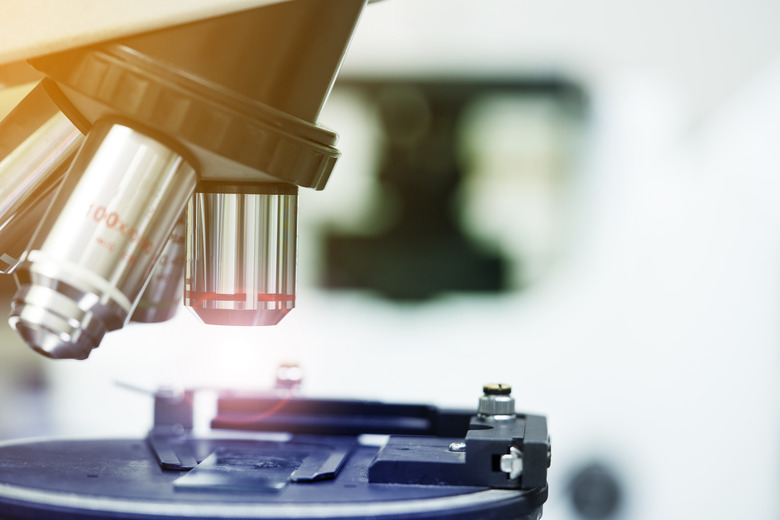How To Calculate Cell Concentration
Scientists and technicians often need to calculate the concentration of cells in a suspension. For example, when a patient gets his blood drawn at a doctor's office, the laboratory can use certain methods to look for the amount of white blood cells in a given volume of blood. This gives the doctor a lot of information about the health about her patient, especially his immune system and whether he is fighting an infection or another illness. Tests like this can look for many other cells in blood as well as spinal fluid and other bodily fluids, such as sperm cell counts in semen for fertility purposes. Scientists also calculate cell concentrations of bacteria, yeasts and other microorganisms for numerous purposes ranging from ecological research to industrial technologies. One of the most common techniques is also taught in many college biology classes, and it uses a device called a counting chamber.
1. Diluting the Sample
Before the cell suspension can go into the counting chamber, it might need dilution because it could contain thousands or millions of cells. In that case, the cells cannot reasonably be counted. To dilute the sample, use a sterile pipette to place ten microliters of the cell solution in a test tube containing 90 microliters of a dilutant. The type of dilutant will depend on the type of cell. Mix it well. This solution is now ten times more diluted than the initial sample, so its dilution factor is 10-1. Label it. Repeat this several times, using a sterile pipette each time, until the solution is dilute enough. If you diluted it a second time, the second test tube was 100 times more diluted than the initial solution, so the dilution factor was 10-2 and so on.
2. Counting the Cells
You may need to try several dilutions to determine the right dilution factor for the counting chamber. A counting chamber is basically a very small, clear, rectangular box with a precise depth and a precise grid inscribed across the top. It is also known as a hemocytometer, or sometimes a hemacytometer. The aim is for the suspension to be dilute enough that when it is viewed in the counting chamber, no cells overlap, and they are distributed throughout the grid in a uniform fashion. Pipette the diluted suspension containing the cells into the well in the counting chamber, where it will settle into the grid chamber through capillary action. Place the counting chamber on the microscope stage and view it under low power.
The grid contains squares which are made of even smaller squares. Select approximately four or five squares, or however many you need to count at least 100 cells, in a pattern of your choosing, such as the four corners and a center square. If the cells are large, these could be the large squares, but if the cells are small, you might choose the smaller squares instead.
3. Calculating Concentration
The specific volume of each grid square may vary by counting chamber manufacturer, but often, the depth of the chamber is 0.1 millimeters, the area of the large squares are 1 square millimeter, and the area of the smaller squares are 0.04 square millimeters. The larger squares, then, have a volume of 0.1 cubed millimeters. For this example, assume you counted a total of 103 cells in five squares, and that you diluted the initial sample until the dilution factor was 10-2.
If each grid square has a volume of 0.1 cubic millimeters and five were counted, then the total volume of the chamber that was counted was 0.5 cubic millimeters, and there were 103 cells. Doubled to make it 1 cubic millimeter would make it 206 cells. One cubic centimeter is equivalent to 1 milliliter, which is a useful measurement for liquids. There are 1,000 cubic millimeters in a cubic centimeter. Therefore, if there had been a cubic centimeter, or a milliliter, of suspension, you would have counted 206,000 (206 x 1,000) cells. This is what it looks like as an equation:
Volume of grid square × number of squares counted = total volume of counted suspension
Number of cells ÷ volume of counted suspension = cell count per millimeters cubed
Cell count per millimeters cubed × 1000 = cell count per milliliter
4. Calculating Undiluted Concentration
You will need to account for any dilution performed to make the initial solution countable under the microscope. In this example, the dilution factor is 10-2. To calculate the initial concentration of the solution:
Cell count per milliliter ÷ dilution factor = Cell concentration
For this example, the cell count per milliliter is 206,000, and dividing that by 10-2 (0.01) gives a cell concentration of 20,600,000 cells per milliliter in the initial sample.
Cite This Article
MLA
E., Rebecca. "How To Calculate Cell Concentration" sciencing.com, https://www.sciencing.com/calculate-cell-concentration-2788/. 19 May 2018.
APA
E., Rebecca. (2018, May 19). How To Calculate Cell Concentration. sciencing.com. Retrieved from https://www.sciencing.com/calculate-cell-concentration-2788/
Chicago
E., Rebecca. How To Calculate Cell Concentration last modified March 24, 2022. https://www.sciencing.com/calculate-cell-concentration-2788/
